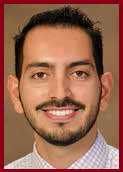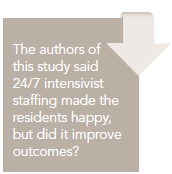Publication
Article
Nighttime Intensivists: A Question of Whether More Is Better
Author(s):
A number of studies have shown that either a "high-intensity" intensive care unit (ICU), in which all ICU patients are cared for by an intensivist, or one in which an intensivist team consult is mandatory, improves outcomes in the ICU. But does the presence of an intensivist in the ICU around the clock improve outcomes?

Mohammad Dalabih, MD,
and Michael P. Habib, MD, CM
Review
Kerlin MP, Small DS, Cooney E, et al. A randomized trial of nighttime physician staffing in an intensive care unit. N Engl J Med. 2013;368:2201-2209.

A number of studies to date have shown that either a “high-intensity” intensive care unit (ICU), in which all ICU patients are cared for by an intensivist, or one in which an intensivist team consult is mandatory, improves outcomes in the ICU.1 But does it follow that the presence of an intensivist in the ICU around the clock would improve outcomes?
A 24-hour-a-day staffing model has both positive and negative features. If an intensive care specialist is present in house around the clock to provide the best evidence-based care in a timely fashion, one might expect an improvement in ICU outcomes, such as in-hospital mortality and ICU length of stay. However, a number of studies—none of which are randomized, controlled studies—produced mixed results. Two major studies that tried to answer this question used a before-and-after study design,2,3 raising the question as to whether the decreased hospital mortality in 1 of the 2 studies could be explained by confounding factors.2 Approximately one-third of US academic ICUs have round-the-clock (24/7) in-house intensivist coverage. Being able to show whether this is indeed necessary or even recommendable would have wide-ranging implications. Showing a clear benefit in ICU outcomes that would justify such a staffing model would result in higher costs to the already most expensive healthcare system in the world—a cost that the taxpayer and the patient would have to shoulder. It would require fellowship programs around the country to train far more intensivists, another cost that “the system” would have to carry. Even in the myriad staffing models currently available, there is still a shortage of intensivists, and some ICUs do not have any intensivist coverage at all.4
This randomized controlled study by Kerlin et al5 from the University of Pennsylvania attempts to answer the question of whether 24/7 in-house intensivist coverage provides better outcomes than daytime intensivist coverage with telephone intensivist consultation at night.
Study Design
Kerlin et al’s study was conducted in an academic medical center.5 The authors described their ICU as a 24-bed, closed ICU staffed by 2 teams with 1 intensivist, 2 fellows, 6 residents, and 1 advanced practitioner on each team—all in house from 7 am to 6 pm. Nighttime staffing consists of 3 residents who are required to review, by telephone, all overnight critical events and admissions with a fellow, an intensivist, or both, within 1 hour of the occurrence. The patient-to-nursing ratio is typically 2:1, making it a very well staffed ICU in one of the leading academic centers in the country.
Over the course of 1 year, minus 2 weeks during the holidays, Kerlin et al randomized each week to the intervention group (intensivist at night) or control group (residents only with telephone consultation). During the control weeks, the day time intensivist and fellow continued to assume responsibility by being available by phone at night. The study team enrolled all patients admitted to the ICU during the year in question, except for those readmitted to the ICU and those in other exceptional circumstances. The primary outcome was ICU length of stay, and the secondary outcomes were hospital length of stay, ICU mortality, in-hospital mortality, ICU readmission, and home discharge. A total of 1598 patients were included in the analysis.
The authors found that night time intensivist staffing made no significant difference in the length of patient stay in the ICU, including those patients admitted at night. Moreover, round-the-clock intensivist staffing had no effect on any of the secondary outcomes. Subgroup analysis showed no benefit during the early months of the academic year, when residents are less experienced. In addition, the presence of the intensivist at night did not result in a significant benefit among the patients with the highest Acute Physiology and Chronic Health Evaluation (APACHE) III scores—the sickest patients, who might be expected to be most likely to benefit. In a Web-based survey of the residents involved in this study, the majority of participating medical residents reported that they felt the presence of an intensivist at night improved outcomes for patients, strengthened educational opportunity among the residents, and did not adversely affect the autonomy of the residents as they cared for their patients.
CommentaryIt Makes the Residents Happier, but…
This randomized trial contends that ICU staffing by an intensivist at night at the University of Pennsylvania medical ICU (MICU) did not have an effect on any of the outcomes studied. The study shows that in an academic MICU similar to the one in which this study was conducted (with similar nighttime telephone consultation with an intensivist), beyond making the majority of residents happier, an intensivist at night appears to have had no tangible effect on the outcome variables studied. However, extrapolating the conclusion from this study by Kerlin et al to all ICUs, most of which are different from the academic high-acuity referral center that was the site for the Kerlin study, would be moot.
The limitations of the study notwithstanding, it remains clear that paying for expensive specialists such as overnight intensivists will be difficult to justify in the future, particularly in academic MICUs; solutions such as MICU telemedicine and nonphysician providers will become more attractive. Whether having telephone consultation with an intensivist within an hour of an event accounted for the similarities of outcomes requires further study.
Central to understanding the results of this study is the debate about why and how intensivists improve outcomes in the ICU. Is it because they improve adherence to evidence-based practices? Or is it due to the emergent minute-by-minute care a physician trained in intensive care can provide? Studies have failed to make an argument for the latter, as even the sickest patients admitted at night with no intensivist coverage had similar outcomes to those admitted during the day.6-8 The former argument has more evidence to support it,3 and if viewed from that perspective, the results of this study make even more sense. In an academic center, the primary role of the overnight ICU residents is to carry out the plans outlined by the day team, plans that intensivists have been shown to enact through evidence-based practices more often than their nonintensivist counterparts do.
It will likely be a long time before we see this question addressed again in a randomized, controlled fashion in the wake of this study, even though there is still a need to assess other kinds of ICUs, such as those in more rural settings, those that are not as heavily staffed, or those in which there is not telephone consultation by an intensivist within an hour of a resident admitting a patient. Until then, it is very important to refrain from leaping to policy-level decisions before the entire picture is clear. Although telemedicine9 may be an attractive option for a cost-burdened system, the evidence supporting it is anything but conclusive. There is evidence suggesting that the use of nonphysician providers, such as NPs and PAs, instead of house-staff has equal effects on most outcomes.10,11 However, an NP’s salary is substantially higher than that of a resident and may result in even higher costs. More randomized, controlled studies need to be performed before utilizing such nonphysician providers to staff ICUs around the clock. From a health policy standpoint, until there is evidence to the contrary, our priority should be to make sure that every critically ill patient is cared for in an ICU staffed by a daytime intensivist1—and not to spend more money staffing a select few ICUs around the clock.
References
1. Wilcox ME, Chong CA, Niven DJ, et al. Do intensivist staffing patterns influence hospital mortality following ICU admission? a systematic review and meta-analyses [published online August 7, 2013]. Crit Care Med. http://www.ncbi.nlm.nih.gov/pubmedhealth/PMH0059064.
2. Blunt MC, Burchett KR. Out-of-hours consultant cover and case-mix adjusted mortality in intensive care. Lancet. 2000;356:735-736.
3. Gajic O, Afessa B, Hanson AC, et al. Effect of 24-hour mandatory versus on-demand critical care specialist presence on quality of care and family and provider satisfaction in the intensive care unit of a teaching hospital. Crit Care Med. 2008;36:36-44.
4. Angus DC, Shorr AF, White A, Dremsizov TT, Schmitz RJ, Kelley MA. Critical care delivery in the United States: distribution of services and compliance with Leapfrog recommendations. Crit Care Med. 2006;34:1016-1024.
5. Kerlin MP, Dylan SS, Cooney E, et al. A randomized trial of nighttime physician staffing in an Intensive Care Unit. N Engl J Med. 2013; 368:2201-2209.
6. Luyt CE, Combes A, Aegerter P, et al. Mortality among patients admitted to intensive care units during weekday day shifts compared with ‘‘off’’ hours. Crit Care Med. 2007;35:3-11.
7. Wunsch H, Mapstone J, Brady T, Hanks R, Rowan K. Hospital mortality associated with day and time of admission to intensive care units. Intensive Care Med. 2004;30:895-901.
8. Arabi Y, Alshimemeri A, Taher S. Weekend and weeknight admissions have the same outcome of weekday admissions to an intensive care unit with onsite intensivist coverage. Crit Care Med. 2006;34:605-611.
9. Thomas EJ, Lucke JF, Wueste L, Weavind L, Patel B. Association of telemedicine for remote monitoring of intensive care patients with mortality, complications, and length of stay. JAMA. 2009;302:2671-2678.
10. Gershengorn HB, Wunsch H, Wahab R, et al. Impact of nonphysician staffing on outcomes in a medical ICU. Chest. 2011;139:1347-1353.
11. Kawar E, DiGiovine B. MICU care delivered by PAs versus residents: do PAs measure up? JAAPA. 2011;24:36-41.
About the Author
Mohammad Dalabih, MD, is a Fellow in Pulmonary and Critical Care at the University of Arizona College of Medicine, Tucson, AZ. His areas of research include pulmonary hypertension, interstitial lung diseases, and ICU quality improvement. He was assisted in the writing of this article by Michael P. Habib, MD, CM, Chief, Medicine Care Line, Southern Arizona Veterans Affairs Health Care System and Professor of Medicine, Arizona Respiratory Center, University of Arizona, Tucson, AZ.






